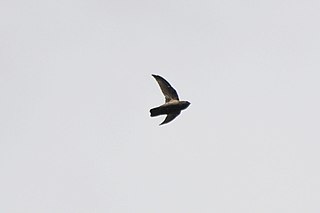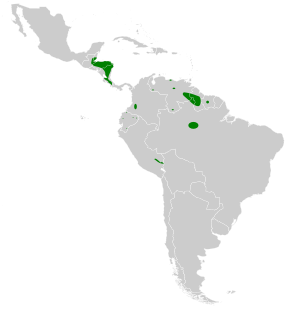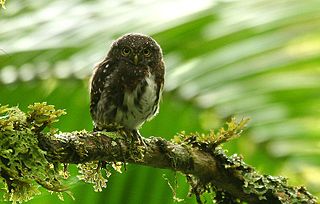
The band-rumped swift is a species of bird in subfamily Apodinae of the swift family Apodidae. It is found from Panama south through Colombia into Ecuador, east from Venezuela into the Guianas and Brazil, and on Trinidad.

The grey-rumped swift is a species of bird in subfamily Apodinae of the swift family Apodidae. It is found in Honduras, Nicaragua, Costa Rica, and Panama; in every mainland South American country except Chile, French Guiana, Suriname, and Uruguay; in Trinidad and Tobago; and on Grenada.

The chestnut-collared swift is a species of bird in subfamily Cypseloidinae of the swift family Apodidae. It is found from Mexico and Trinidad south to Peru and Bolivia..

The green thorntail is a small hummingbird in the "coquettes", tribe Lesbiini of subfamily Lesbiinae. It is found in Colombia, Costa Rica, Ecuador, and Panama.

The white-collared swift is a species of bird in subfamily Cypseloidinae of the swift family Apodidae. It is found in Mexico, the Greater and Lesser Antilles, Trinidad, and every mainland South America country except Uruguay.

The bronze-tailed plumeleteer is a species of hummingbird in the "emeralds", tribe Trochilini of subfamily Trochilinae. It is found in Colombia, Costa Rica, Ecuador, Nicaragua, and Panama.

The blue-vented hummingbird is a species of hummingbird in the "emeralds", tribe Trochilini of subfamily Trochilinae. It is found in Costa Rica and Nicaragua.

The white-tailed emerald is a species of hummingbird in the "emeralds", tribe Trochilini of subfamily Trochilinae. It is found in Costa Rica and Panama.

The scaly-breasted hummingbird or scaly-breasted sabrewing is a species of hummingbird in the "emeralds", tribe Trochilini of subfamily Trochilinae. It is found in Belize, Colombia, Costa Rica, Guatemala, Honduras, Mexico, Nicaragua, and Panama.

Chapman's swift is a species of bird in subfamily Apodinae of the swift family Apodidae. It is found in Bolivia, Brazil, Colombia, French Guiana, Guyana, Panama, Peru, Suriname, Trinidad, Venezuela, and possibly Ecuador.

The pale-rumped swift is a species of bird in subfamily Apodinae of the swift family Apodidae. It is found in Bolivia, Brazil, Colombia, Ecuador, and Peru.

The Lesser Antillean swift is a species a species of bird in subfamily Apodinae of the swift family Apodidae. It is found on Dominica, Guadeloupe, Martinique, Saint Lucia, Saint Vincent, and possibly Nevis.

The spot-fronted swift is a species of bird in subfamily Cypseloidinae of the swift family Apodidae. It is found in Colombia, Costa Rica, Ecuador, Panama, Peru, and Venezuela.

The white-chinned swift is a species of swift in the family Apodidae. It is found from Mexico south through most Central America countries into South America as far south as Peru and east as far as Suriname.

The Costa Rican pygmy owl is a small "typical owl" in subfamily Surniinae. It is found in Costa Rica and Panama.

The maroon-chested ground dove is a species of bird in the family Columbidae. It is found in Bolivia, Colombia, Costa Rica, Ecuador, El Salvador, Guatemala, Honduras, Mexico, Panama, Peru, and Venezuela.

The tawny-faced gnatwren or half-collared gnatwren is a species of bird in the family Polioptilidae, the gnatcatchers. It is found in Bolivia, Colombia, Costa Rica, Ecuador, Nicaragua, Panama, and Peru.

The timberline wren is a species of bird in the family Troglodytidae. It is found in Costa Rica and western Panama.

Vaux's swift is a small swift native to North America, Central America, and northern South America. It was named for the American scientist William Sansom Vaux.

The isthmian wren is a species of bird in the family Troglodytidae. It is found in Costa Rica and Panama.























